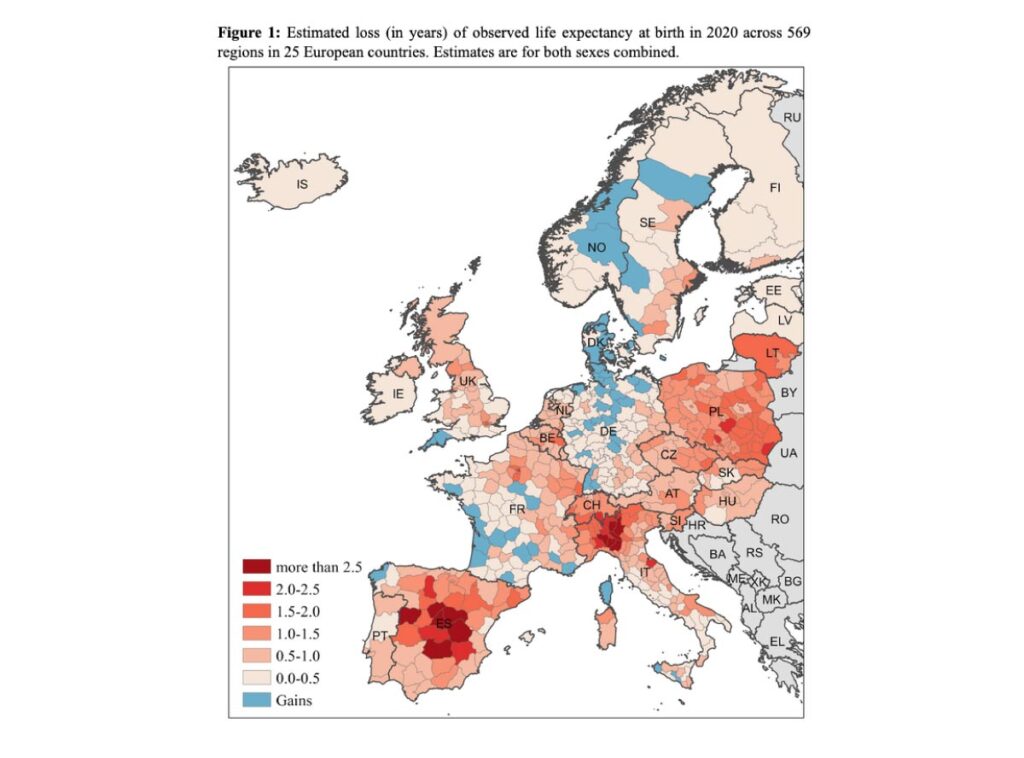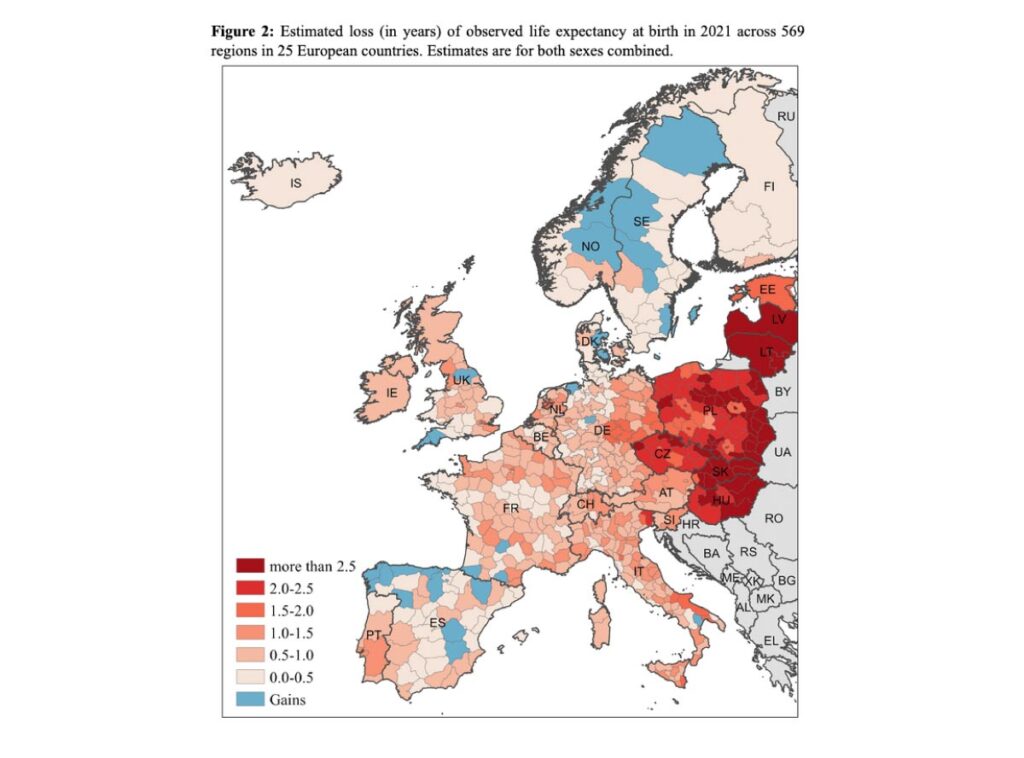Europe was hard-hit by the COVID-19 pandemic in 2020 and 2021. While its effects at national level are now well known, intranational differences have been less frequently investigated. Florian Bonnet, Pavel Grigoriev, Markus Sauerberg, Ina Alliger, Michael Mühlichen and Carlo-Giovanni Camarda fill this knowledge gap and show that considerable heterogeneity exists at regional level, even within the same country.
In 2020 and 2021, drastic measures were taken to combat the COVID-19 pandemic, contain the spread of the virus and limit the number of deaths. The efficacy of these measures, initially hard to evaluate (Caporali et al 2022), can be better assessed today, as reliable estimates of deaths caused by this pandemic are now being published by major research institutes in scientific journals and by international organizations. In a report issued in May 2024, for instance, the World Health Organization (WHO) estimated that life expectancy dropped by 1.8 years between 2019 and 2021 globally, erasing a decade of progress.
COVID-19-related excess mortality
These estimates are derived from what is known as excess mortality, which represents the difference between observed mortality during the pandemic years and the mortality that would have been expected in its absence. Excess mortality can be quantified using different indicators, such as the number of excess deaths. However, comparing this indicator between countries of different sizes and age structures can be misleading. Another informative metric is the loss of life expectancy at birth, calculated globally by organizations like WHO.
The regular calculation, publication, and dissemination of excess mortality indicators serve as crucial tools for comparing the pandemic’s impact across different countries at national level. However, the pandemic did not have a homogeneous impact at subnational level, primarily due to the varying confinement strategies implemented to curb the spread of the virus. This variability underscores the importance of quantifying these indicators at a more granular geographical level to highlight the pandemic’s impact in the regions most severely affected. Detailed geographical analysis of excess mortality can thus localize the effect of the pandemic and help tailor response strategies accordingly.
Mortality in Europe at subnational level: 2020 and 2021
In a series of studies published in 2024, we first proposed an innovative method to calculate excess mortality at a fine regional level (Bonnet and Camarda 2024), then used this method to estimate the levels of excess mortality in 561 European regions covering 21 countries in 2020 (Bonnet et al 2024a). We finally expanded our geographical scope to 569 regions covering 25 European countries, differentiating between the two pandemic years, 2020 and 2021 (Bonnet et al. 2024b). These estimates are the outcome of a thorough process involving the collection of data from a wide array of national statistical institutes. Here, we present our findings based on loss of life expectancy at birth for both sexes combined.
Figure 1 depicts the spatial distribution of the estimated life expectancy losses in 2020. Losses were highest in northern Italy and central Spain, with values close to 4 years in the regions of Bergamo and Cremona, 3.5 years in Piacenza, and 3 years in the Spanish regions of Segovia, Ciudad Real, Cuenca, and Madrid. They are even higher when considering only men (not shown here), who were more severely affected by the pandemic: life expectancy loss is close to 5 years in Cremona and 4.5 years in Bergamo. Losses in 2020 were more moderate, though still dramatic, in eastern Europe (notably in Poland), eastern Sweden, and northern and eastern France. In the latter, the Paris region and areas near the German border showed the highest values, ranging from 1.5 to 2 years. Conversely, the losses were much lower in other geographical areas, such as southern Italy, much of Scandinavia and Germany, and western France, where life expectancy remained close to what would have been expected in the absence of the pandemic.


Figure 2 presents the estimated life expectancy losses in 2021. At first glance, the regions affected by excess mortality were not the same as in 2020. The most significant losses were predominantly in eastern Europe. More broadly, among the regions where life expectancy losses exceed 2 years, we find 61 of the 73 Polish regions, 12 of the 14 Czech regions, all eight Hungarian regions, seven of the eight Slovak regions, but only one Italian region and one Spanish region, even though these two countries were also heavily impacted in 2020. Moreover, the life expectancy losses were much greater in Germany in 2021 than in 2020, especially in the eastern part of the country where values often exceed 1.5 years. In southern Saxony, Halle, and Lusatia, losses were nearly 2 years. Conversely, the lowest values were observed in Spain and Scandinavia. In France, life expectancy losses were more uniform than in 2020, generally ranging between 0 and 1.5 years, with the highest loss in the Parisian suburbs (Seine-Saint-Denis) where it reached 1.5 years (2 years for men).
Ranking European regions
Combining the data from both years, an overall assessment of the mortality impact of COVID-19 is possible (Bonnet et al 2024b). The regions where mortality increased the most in 2020 and 2021 are Pulawy, Bytom, and Przemyski in south-eastern Poland, and Kosice and Presov in eastern Slovakia. More broadly, eastern European regions predominate among the top 50 regions, which include 36 Polish regions, six Slovak regions, two Czech regions, one Hungarian region, and the two Lithuanian regions. Notably, the Italian regions of Cremona, Bergamo, and Piacenza complete this panel, ranging between the 15th and 30th places. In France, Seine-Saint-Denis ranks 81st, while all other French regions rank below the 100th place.
Conclusions
In conclusion, analyzing the impact of a crisis like the COVID-19 pandemic on longevity at a fine geographical scale is essential, as within-country disparities can be significant. This was notably true for Italy in 2020 (between the South and the North), and for Germany in 2021 (between the west and the east). Our study highlighted the severe impact of the pandemic in certain European regions, where the loss of life expectancy exceeded 3 years. The most affected regions shifted between 2020 and 2021, moving from areas with traditionally high life expectancy (northern Italy, central Spain, Greater Paris) to those with traditionally low life expectancy (Eastern Europe). France was relatively spared compared to the rest of Europe except for Seine-Saint-Denis. The coming years will be crucial for determining whether life expectancy levels return to their long-term trajectory or whether the pandemic has caused a structural impact in certain regions.
References
Caporali, A., Garcia, J., Couppié, É., Poniakina, S., Barbieri, M., Bonnet, F., … & Torres, C. (2022). The demography of COVID-19 deaths database, a gateway to well-documented international data. Scientific Data, 9(1), 93.
Bonnet, F., & Camarda, C. G. (2024). Estimating subnational excess mortality in times of pandemic. An application to French départements in 2020. PLoS ONE, 19(1), e 0293752.
Bonnet, F., Grigoriev, P., Sauerberg, M., Alliger, I., Mühlichen, M., & Camarda, C. G. (2024a). Spatial variation in excess mortality across Europe: a cross-sectional study of 561 regions in 21 countries. Journal of Epidemiology and Global Health, 1-10.
Bonnet, F., Grigoriev, P., Sauerberg, M., Alliger, I., Mühlichen, M., & Camarda, C. G. (2024b). Spatial disparities in the mortality burden of the covid-19 pandemic across 569 European regions (2020-2021). Nature Communications, 15(1), 4246.


